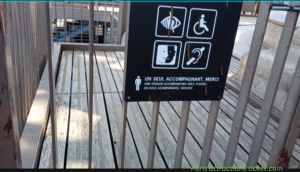Table of Contents
Accessibility at the Eiffel Tower is something that is well observed. At one of the most iconic landmarks in the world, attracts millions of visitors each year. Whether you’re traveling with young children, elderly family members, or someone with mobility challenges, accessibility is a key concern for many. Fortunately, the Eiffel Tower is committed to providing an inclusive experience for all visitors, ensuring that everyone can enjoy this majestic structure and its stunning views. In this comprehensive guide, we will explore the various accessibility features at the Eiffel Tower, so you can plan your visit with confidence and ease.
1. Wheelchair Accessibility at the Eiffel Tower
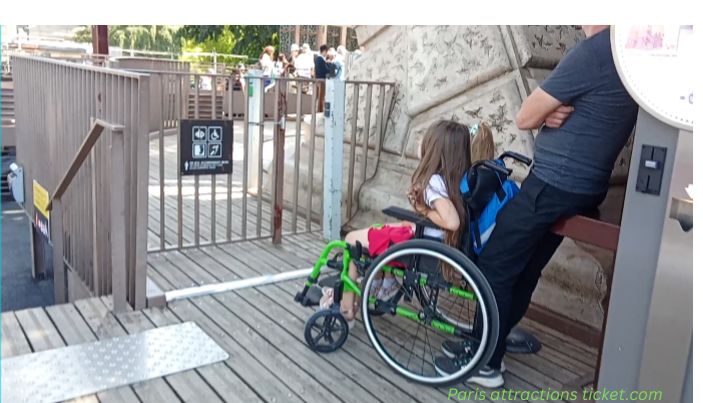
The Eiffel Tower is fully accessible to people with disabilities, including wheelchair users. The main entrance to the tower is wheelchair-friendly, and there are dedicated entrances that cater to those with mobility challenges.
Elevator Access:
- The Eiffel Tower’s elevators are equipped to accommodate wheelchairs, allowing easy access to the first, second, and summit floors.
- The elevators are spacious and well-maintained to ensure a comfortable ride for visitors with mobility aids.
- There is a dedicated queue for visitors with disabilities to avoid long waits.
Wheelchair Rental:
- Free wheelchair rentals are available for visitors who need assistance. These can be borrowed at the ticket offices at the base of the tower.
- It’s advised to call ahead or check the Eiffel Tower’s official website to confirm availability, especially during peak tourist seasons.
Elevator Assistance:
- If you require assistance with the elevators, staff members are available to help. Simply ask a staff member upon arrival for guidance.
2. Accessible Bathrooms
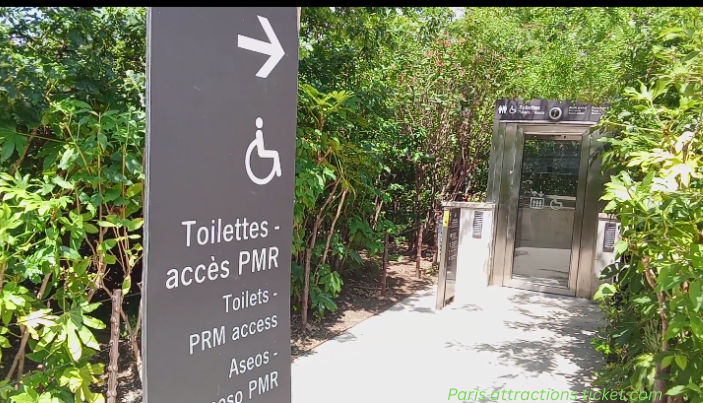
The Eiffel Tower provides accessible restrooms for people with disabilities on various floors, including the base, first, and second floors. These restrooms are spacious and equipped to cater to the needs of visitors with mobility challenges.
Accessible Features:
- Wide doors for wheelchair access.
- Lowered sinks and mirrors for ease of use.
- Grab bars and other safety features are in place to ensure a safe and comfortable experience.
These facilities are regularly maintained and provide a high level of accessibility for all visitors.
3. Accessible Entrance
For individuals with reduced mobility or who are traveling with a wheelchair, there is a dedicated accessible entrance to the Eiffel Tower. This entrance allows quicker access to the elevators, ensuring that visitors with mobility challenges can avoid long waiting times. The staff is trained to offer assistance and guide visitors through the entrance.
4. How to Get to the Eiffel Tower: Accessible Transportation
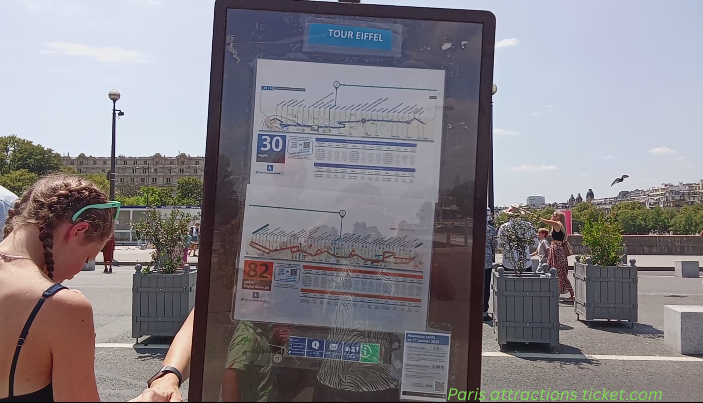
Getting to the Eiffel Tower with ease is important for visitors with mobility challenges. The landmark is well-connected to various modes of accessible transportation.
Public Transport:
- Metro: The closest metro station to the Eiffel Tower is the Champ de Mars – Tour Eiffel station (Line C). This station is wheelchair accessible and has ramps and elevators for easy access. Additionally, the Bir-Hakeim (Line 6) station is also a good option and has elevator access. Get your bus ticket
- Bus: There are several buses that stop near the Eiffel Tower, including buses with wheelchair-accessible features. Look for the 63, 69, 82, and 42 lines, which are all accessible to those with mobility issues.
Taxis and Ride-Sharing Services:
- Many taxis and ride-sharing services, such as Uber, offer vehicles that accommodate wheelchairs. It’s advisable to book a specialized vehicle in advance to ensure a smooth and hassle-free trip to the Eiffel Tower.
5. Accessibility to the Summit
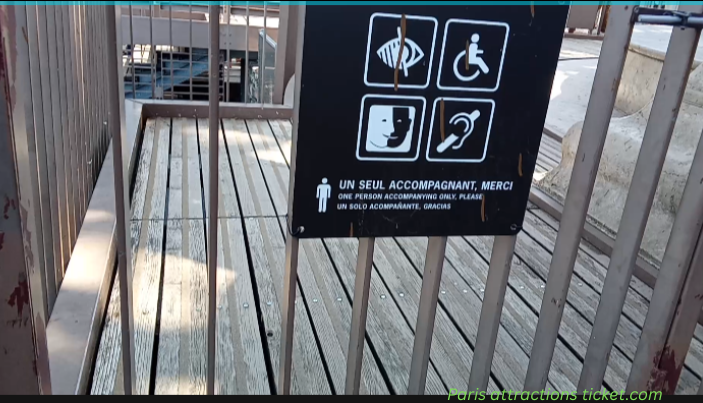
One of the key challenges for visitors with mobility issues is reaching the top of the Eiffel Tower, also known as the summit. Fortunately, accessibility has been improved, and there is an elevator service that takes visitors to the summit.
Elevator Ride to the Summit:
- The elevator ride from the second floor to the summit is fully accessible. It can accommodate wheelchairs and other mobility aids.
- It’s worth noting that the first and second floors are also accessible via elevator, which allows visitors to explore the tower’s levels without needing to climb stairs.
Access to the Summit Platform:
- The summit provides panoramic views of Paris and has wide platforms, making it accessible for people with reduced mobility.
Important Tip: For visitors who have specific mobility needs or require extra assistance, it’s advisable to contact the Eiffel Tower in advance and inquire about special arrangements for accessing the summit.
6. Assistance for Visitors with Disabilities
Eiffel Tower staff is trained to assist visitors with disabilities. If you need any special assistance during your visit, the staff is available to help you at all times. This includes assistance with:
- Entering and exiting the elevator.
- Guiding visitors to accessible restrooms.
- Providing information about accessibility features.
There are also specific support services available for hearing-impaired visitors, and staff can offer guidance on how to navigate the tower safely.
7. Accessibility for People with Visual or Hearing Impairments
The Eiffel Tower is also mindful of accessibility for individuals with visual or hearing impairments. There are a number of features designed to enhance the experience for these visitors:
For Visually Impaired Visitors:
- Tactile Experiences: The Eiffel Tower offers tactile models of the tower at certain levels, allowing visually impaired visitors to explore its structure through touch.
- Guided Tours: Visitors with visual impairments can request a guided tour, and staff can provide assistance and additional information during the visit.
For Hearing-Impaired Visitors:
- Visual and Written Information: The Eiffel Tower provides written and visual information to help hearing-impaired visitors navigate the tower and learn about its history.
- Sign Language Assistance: Staff can also arrange sign language assistance, though advance notice is recommended for this service.
8. Family-Friendly Accessibility
The Eiffel Tower is a great place for families, and there are several family-friendly features to make your visit easier and more enjoyable:
- Stroller Access: The Eiffel Tower is stroller-friendly, and families can easily navigate the structure with a stroller.
- Elevators for Families with Small Children: Families with small children can use the elevators to reach various levels of the tower, ensuring a comfortable experience for everyone.
9. Tips for a Smooth Visit to the Eiffel Tower
Here are some practical tips to ensure a smooth and accessible visit to the Eiffel Tower:
- Plan Ahead: Check the Eiffel Tower’s website for the latest information on accessibility features, including entrance details and special services.
- Arrive Early: Arriving early helps avoid long lines and allows you to enjoy a more relaxed experience.
- Consider Time of Visit: Peak hours and seasons can lead to longer wait times. Plan your visit for early mornings or late evenings when it’s less crowded.
- Ask for Help: If you need assistance with anything, don’t hesitate to ask one of the staff members. They are there to ensure you have a comfortable and enjoyable visit.
Conclusion: A Fully Accessible Experience at the Eiffel Tower
The Eiffel Tower is fully committed to providing an accessible and inclusive experience for all visitors, ensuring that everyone can enjoy its iconic views and architectural marvels. With wheelchair-accessible elevators, dedicated entrances, accessible bathrooms, and transportation options, a visit to the Eiffel Tower is made easy for visitors with mobility challenges. Whether you’re traveling with a wheelchair, stroller, or need assistance with hearing or visual impairments, the Eiffel Tower offers a welcoming and accessible environment.
Make sure to plan your visit in advance to take advantage of all the accessibility features and enjoy a seamless, memorable experience at this world-renowned monument.
FAQs about accessibility at the Eiffel tower
Can I take a wheelchair to the top of the Eiffel Tower?
No, wheelchairs can be used in the elevators, which take you to the first and second floors. For the summit, no strollers no wheelchairs are allowed
Do I need to queue for the elevator if I have a disability?
There is a dedicated elevator queue for visitors with disabilities, so you do not need to wait in the regular line.
Is there any assistance available for visitors with hearing impairments?
Yes, the Eiffel Tower provides visual and written information for visitors with hearing impairments. Sign language assistance can be arranged upon request with prior notice.
Are there tactile experiences available for visually impaired visitors?
Yes, the Eiffel Tower offers tactile models of the tower at certain levels, allowing visually impaired visitors to touch and explore its structure.
Can I get assistance with navigating the Eiffel Tower?
Yes, staff members are available to assist visitors with disabilities. You can ask for help when needed, and the staff will guide you through the tower’s accessible features.
What is the best time to visit the Eiffel Tower for visitors with mobility challenges?
It’s best to visit during off-peak hours, such as early mornings or later in the evening, to avoid long queues and crowded areas, making the experience more comfortab

